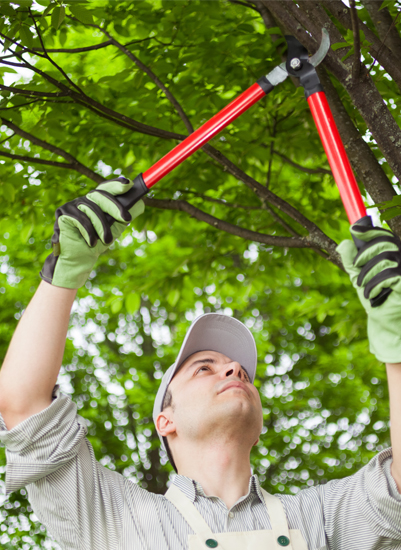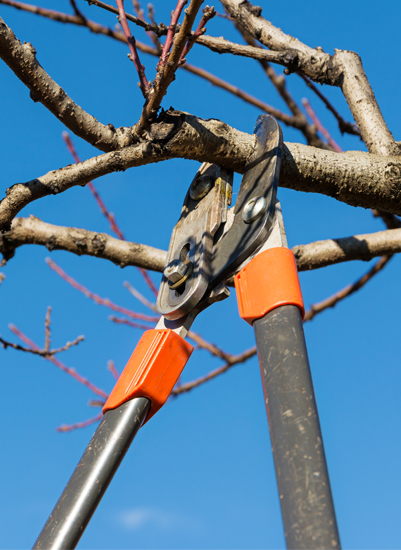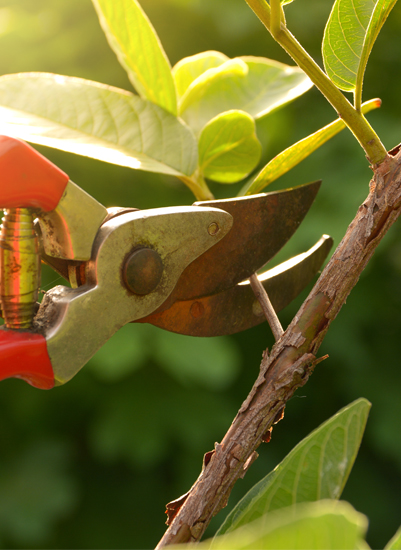Shrub Pruning



Why Shrub Pruning Is Essential
Trees growing in your backyards don’t have as much freedom compared to trees growing in the forest, and that’s for a good reason. Although you want your trees to grow and look natural, you must ensure that their tall and strong physique won’t pose any risk to you or anyone near it.
This is where pruning becomes significant. Pruning is one of the best ways to keep your trees in great shape. This technique is used when you selectively remove branches from a tree to improve the tree’s structure and direct new and healthy growth.
Pruning is a unique technology that works best for both young and mature trees. With proper pruning, a tree can be made to grow into a specific configuration of limbs and branches ideal for the tree’s structural integrity.
Benefits of Pruning
Pruning, being a process of removing dead and damaged branches and stubs of plants, trees, and shrubs, permits the development and the natural beauty of your plants and trees.
It allows for the growth of new branches and removes those detrimental to your plants and trees’ overall well-being. In other words, when you remove old branches, you give trees the green light to put out healthy, new growth.
Pruning additionally deters bugs and pest invasion and advances the plant’s natural shape and healthy development.
Pruning encourages the production of safe leafy foods for trees and shrubs. Standard cutting produces a fence feel and holds evergreens in proportion and thickness.
Such maintenance underpins the arranged design and appearance of your property by regulating plant size and shape. Through pruning, you’re giving your trees a clean, polished look that can elevate your whole scenery.
Aside from the benefits that plants may get from pruning processes, it likewise keeps your yard and your family safe from falling branches and fungi infiltration that can be hazardous to your health. Custom pruning reduces the risk of damage to broken branches systems.
Cover your loved ones from dropping branches over walkways, garages, and playgrounds for youngsters. This process also helps control insects, vermin, and snakes by decreasing their natural surrounding and habitat.
Types of Pruning
Essentially, there are two forms of pruning: primary and support. The main objective of essential pruning is to shape and allow the tree to accept its new structure.
The purpose of supporting pruning is to enhance plant growth and sturdiness to ensure that the tree or plant does not grow too big for the container. As a professional tree service provider in Corpus Christi, below are the following services we provide.
Essential pruning is usually performed on young trees that should be prepared in a specific style of bonsai. It requires pruning the tree’s critical sections because of which the tree is under a great deal of strain.
It is also essential that the simple pruning is performed during the growing season or when the tree is lethargic. The measure of significant pruning that should be necessary on the tree depends on the plant, the season, and the soil in which the tree is pruning.
Support Pruning is done to keep up the bonsai’s shape and size just as to energize new development and tree improvement. It very well may be done whenever consistently, yet is commonly done during the development season.
Overwhelming upkeep pruning is usually performed in pre-summer throughout much of the mid-year period since this is the point at which the tree is likely to go astray from its form.
Likewise, because a large part of the new growth is at the top of the tree’s outer part, regular pruning would allow more vegetation to be developed on the inner part of the tree.
The advantages of upkeep pruning are that the difference between the interns is minimized, the branch repercussion is improved, and the inner growth is assisted. This leads to a change in the bonsai tree’s overall feel, making it look more developed.
Branch pruning helps to monitor the tree’s growth and progress as it is being shaped and packed. The upper part of the tree grows more rapidly than the lower part, with the most complex growth occurring in the apical bud. The apical bud absorbs more vitamins and water.
As the apical bud hinders parallel buds’ growth, the outer portion of the tree grows more successfully than the rest.
As the light and air will enter the lower branches or the inner leaves, it is essential to trim the tree’s crown, which allows the branches to be pruned, rather than only shoots or leaves.
Shoot pruning is among the critical aspects of the pruning process. As it grows and develops, the bonsai will eventually lose its shape and expand out of its container. It is during this time that shoot pruning comes into play.
It limits the bonsai from expanding excessively and keeps it in its natural form. During the growing season, whatever other development may be seen on the bonsai tree, which influences the tree’s state or gives it an uneven look, shoot pruning becomes essential.
Utilizing a couple of sharp scissors and other garden tools, shoots are pruned to perfection, making the bonsai’s natural shape and beauty to reveal. Generally, shoots may have 5-6 arrangements of leaves, and it is informed to prune to 2 sets regarding leaves.
Leaf pruning is a process that involves harvesting leaves from trees and shrubs and broad-leaf bonsai trees and is often known by names such as leaf-cutting. It relates to the completion or halfway elimination of the leaves of a bonsai tree.
Leaf pruning is performed distinctively on the completed and ready bonsai. The storage compartment, the primary, optional and tertiary branches are enclosed.
The guideline behind the whole technique is to facilitate the emergence of many smaller leaves by restricting the bonsai to produce a replacement collection of leaves after the leaves’ prior arrangement, which has solidified, has been removed.
New arrangements for growing leaves have reduced leaf size and internode length. In the same way, this method constructs the branch effect of the network.
Bud pruning is a technique used much of the time alongside branch pruning. It is performed when working with the generated bonsai. Each of these procedures aims to grow small branches and leaves and eat the last form of bonsai.
When the bonsai tree is already done with regards to its form or where the branches are not expected to be pruned but just stifled, bud pruning or squeezing is performed instead of branch pruning.
Bud squeezing should be performed as new buds arise, and only apical buds should be expelled to impede the branches’ growth.
Shrub Pruning Tips
Shrubs take on important business in your house, filling up as enriching fringes, living walls, and plantings that bring contrast and character to your property. Be that as it may, if your shrub is steeply scrolling all over your walkway, it may be a perfect time to break out the pruning shears.
Irrespective of how much you’re merely trying to monitor the supports’ rapid production under your windows, or you need to increase the number of sprouts, correct pruning is crucial. So, before you start chopping, set yourself up with this outline of simple rules and regulations.
Does your shrub look great so far? Promptly eliminate any dead branches by cutting them as close to the shrub’s whole stem as might be required under the conditions.
This is also an opportunity to inspect the root ball and eradicate damaged roots. If not, it will infect the rest of the shrub.
Remove any giant roots (thicker than your little finger) that have grown in a hover around the root ball since these “supporting” roots would never repair and will ultimately grow out of the shrub.
Dull, sharp edges will damage the limbs, creating tears that contribute to illness. Hone the pruning machines to ensure the smoothest cuts and keep them sterile, so they do not communicate contaminants from a diseased shrub to a good shrub.
Washing equipment before each application and in the middle of using on singular shrubs is vital for a perfect pruning process to transpire.
More so, by washing them with scouring liquor, a family unit disinfectant, or a 10% family dye and water treatment, the equipment can function well and allow for a perfect, easy, and fast work to happen. Scissors are generally the most utilized tool when pruning shrubs, so make sure always to sterilize them.
Spring-blooming shrubs produce buds that will pop up next year during the early pre-and late-summer seasons. Suppose you prune during the fall or winter. In that case, these likely sprouts will be eliminated, which will lead to virtually no growth in the accompanying spring.
Summer-blooming shrubs, e.g., roses and crape myrtle, produce buds in the pre-summer and late-spring seasons and can be pruned during lethargy in the pre-spring or late-winter seasons to invigorate the flowering.
Irrespective of what kind of shrub you have, dropping pruning can allow late-season growth that may not have enough ability to solidify, which could weaken and damage the plant — especially if there is an early frost. Keep up until there’s a shrub down in lethargy to make it a trim.
In comparison to sporadic pruning, the upkeep pruning process is increasing. This includes replacing sick or broken branches and the constant cutting of every rapidly emerging juvenile throughout the growing season—breakpoint support pruning to repair fast problems and never eliminate more than is needed.
Shrubs with ample light and air diffusion are better than shrubs with limited focal points. To thin a dense shrub, prune up to thirty-three percent of the lateral branches, converging with the main stem.
If it is a multi-stem shrub, trim the leaves at ground level. By exposing the central point of the shrub, you’re going to ensure that it receives enough ventilation and light.
The least complicated design to catch pace is one that is usually natural for your shrub. This consideration is equally essential during the shrub-purchase stage for the value of the pruning process.
By understanding what your shrub can look like as a built-up example, you’ll know where it suits best in your scene and how to prune it to amplify its showcase value.
The cutting of the head of a shrub is a drastic advancement, and it doesn’t work. By shearing off the top to get a 3D form look, you’re going to reinvigorate the leggy vertical construction that creates the unattractive “witches’ brush” effect.
Even if you’re in the shrub market, you’re in an optimal position just by decreasing your branches’ size. Note, though, that the bud face determines the direction of the new creation.
Process Pruning to Revive A Declining Shrub
Offer the old woody trees a revived intent to carry on through life by trimming the more mature wood to promote new growth. The new branch nestlings will send you more flowers, so you’ll have a chance to keep a more mature shrub looking young for a long time to come.
Cut the inside of a one-quarter inch of the stem when evacuating the side branches. Pruning flush with the main stem at a branch’s place of root gives the shrub it’s most apparent opportunity regarding recuperating from the injury.






